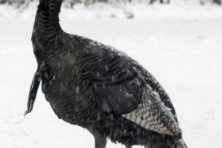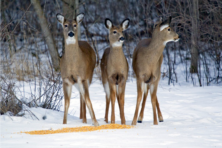Door to Nature: Wild Turkeys
- Share
- Tweet
- Pin
- Share

When I moved here in 1972 there were no wild turkeys roaming the woods and fields. This is a species that had been native to much of the southern two- thirds of Wisconsin, but seemed to be very low in numbers 50 years ago. They were nearly eliminated in our state in the late 1800s due to over-hunting and loss of habitat. The fact that this species is hunted and becomes the star of a large family dinner during the holidays may have also have contributed to its decline.
Severely bad winter weather with deep, crusted snow in 1843 caused a great number of wild turkeys to perish. The first restocking of turkeys was done in a period from 1929 to 1939 in Grant and Sauk counties. The last survivor of that group was thought to have died in Adams County in 1958.
Other wild turkeys in western Wisconsin, where their survival was slightly better, suffered big losses of young birds due to heavy rains in 1967-68. The state brought more turkeys to Vernon and Buffalo counties in the 1970s-80s. Their numbers increased well enough to establish a hunting season by 1983.
A major restoration project begun in 1976 has increased their population to a high level now, with flocks raised in Missouri brought into the state. Door County had several introductory flocks brought here in the 1980s and they have been very successful in populating most of our area – to the point where some homeowners and gardeners feel there are now too many of these large birds.
(When I googled wild turkey, the first site that came up was the name of a Kentucky straight bourbon whiskey! Birds seem to be popular names for some beverages, like Cold Duck and Old Crow.)
The wild turkey is one of only two domesticated birds native to the New World – the other one is the Muscovy duck – and is found all year in most areas of our country except the deserts and high mountains. Its name is thought to have come from the fact that these birds were shipped to European markets through the country of Turkey.
A friend enjoyed hunting them in the southwestern part of Wisconsin. One spring a frozen turkey was given to us that was an extra from the hunt. I thawed it in our basement refrigerator for a few days and had to cut the legs off because they were too tough.
Once I got the bird into the roasting pan, I tried to season it but the bird was not like one you buy in a store. Its breast was shaped like an A-frame house and none of the seasoning stuck to the steep sides. I let it roast for a half hour and as the juices flowed, I could then sprinkle seasoning on it and it stayed in place. It was the best-tasting turkey we ever had!
The reestablishment of wild turkeys in the state has made many hunters happy. The turkey-hunting season begins in mid-April and runs until the end of May, with tags purchased for each one-week hunting period.
Turkey-breeding season starts in early March, with males gobbling and “strutting” – puffing up their feathers and spreading their tails – to lure the females. Females build their nests in April to late May. Eggs are laid as early as late April in the southern part of the state to late August in more central and northeastern sections. I have seen a female turkey with a large brood of rather small chicks in September in the central part of Door County.
It was found that turkeys will quickly re-nest if the first one is destroyed and that may be the reason we see these late broods. The average egg-clutch is 11. Only the female does the incubation and that will take about four weeks.
The turkey youngsters are able to fly as soon as 10 days old and will be roosting in trees by the time they are two weeks old. Wild turkeys have only one brood per year.
Wild turkeys are quite rare in the northern forests of Wisconsin. It appears that our wild turkey population is stable and will keep the hunters supplied with game for the next spring season. And this year’s very abundant acorn crop from the northern red oaks will help to feed these large birds – as well as the white-tailed deer and squirrels.



